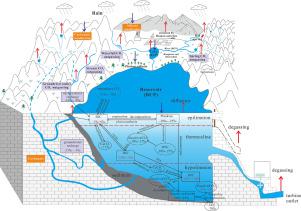Water Research ( IF 11.4 ) Pub Date : 2021-11-29 , DOI: 10.1016/j.watres.2021.117905 Jianhong Li 1 , Junbing Pu 2 , Tao Zhang 2

|
Most reservoirs in subtropical areas experience periodic variations in the thermal structure of their water columns, with times of strong thermal stratification being succeeded by periods of mixing, over the course of the year. Understanding of the transport and transformation of dissolved inorganic carbon over such thermal cycles in artificial reservoirs remains poor. To address this problem, this study examined the spatiotemporal behavior of dissolved inorganic carbon (DIC), the partial pressure of CO2 (pCO2), carbon isotope ratios (δ13CDIC), and CO2 emission (FCO2), from 2014 to 2018 in a subtropical, groundwater-fed reservoir in southern China. It was found that CO2 emissions during mixing periods are much higher than in thermally stratified periods (particularly during transition from stratified to mixing) as a result of upwelling and release of dissolved CO2 (CO2aq) accumulated in the hypolimnion. CO2 emission fluxes at the water-gas interface accounted for only a small proportion of the DIC in the reservoir. The relationships between of DIC and δ13CDIC displayed two distinct modes, due to spatial differences in water depths and to strong thermal stratification during warmer seasons: (1) DIC concentrations increase and δ13CDIC values decrease from epilimnion to hypolimnion, and (2) δ13CDIC values decrease with increasing DIC concentrations but δ13CDIC is progressively enriched near the bottom during periods of thermal stratification. In addition, this study found three distinct processes of DIC accumulation and consumption in the reservoir: (1) DIC accumulated in the hypolimnion during thermal stratification periods, due to carbon retention but (2) DIC was substantially consumed in the epilimnion during such periods, and (3) average DIC concentrations and pCO2 increased significantly from upstream to downstream along the reservoir, while average δ13CDIC values became lighter. These results highlight that carbon behavior in groundwater‑fed reservoirs is often controlled by a combination of biogeochemical processes and seasonal variations in thermal structure. Sampling and monitoring strategies should consider these factors in order to accurately estimate carbon budgets in reservoirs, lakes or ponds.











































 京公网安备 11010802027423号
京公网安备 11010802027423号